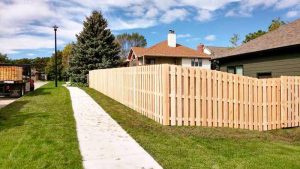 Your backyard area seems private and secluded with a privacy fence. This is crucial if your backyard confronts busy roads, business structures, or other homes with unpleasant elements you wish to hide when partying or unwinding there. In addition to the street, surrounding sources of noise pollution like motorways, airports, or commercial sectors can also be mitigated by fences.
Your backyard area seems private and secluded with a privacy fence. This is crucial if your backyard confronts busy roads, business structures, or other homes with unpleasant elements you wish to hide when partying or unwinding there. In addition to the street, surrounding sources of noise pollution like motorways, airports, or commercial sectors can also be mitigated by fences.
Although there are numerous other materials that can be used to make fences, wood is the most common option. Cedar is the most popular wood for privacy fences because it has an organic, earthy appearance and natural qualities like moisture and pest resistance. Although cedar can be slightly more expensive than other wood species, like pine, the added cost is definitely worth it if you want a fence that is more durable and of superior quality.
Redwood is a further alternative for a privacy fence and has the added benefit of being both elegant and strong. It is more expensive than other kinds of wood, but it won’t need to be stained and refinished as frequently as some other woods will over time. Other options for a privacy fence include bamboo, which is also less expensive and more environmentally friendly than cedar. When combined with a wood or vinyl railing, a bamboo slat fence may create a charming, rustic appearance that is both aesthetically pleasing and utilitarian.
Last but not least, a privacy fence helps prevent burglary by preventing onlookers from seeing your property. This will make it harder for would-be burglars to see what’s inside your house, which may be a big help if break-ins or other criminal activity are common in your community. Furthermore, some privacy fences are made to be challenging to scale, which increases their security advantages.
It is advised that you get in touch with a qualified privacy fence contractor if you’re thinking of putting a privacy fence to your house. These experts can help you choose the best kind of fence for your needs and offer you a free consultation and quote. They can also assist you in calculating the project’s expenses, including labor and material expenditures. They can also assist you in fulfilling any zoning or local restrictions, which may have an impact on the design of your fence, such as permits or utility lines.